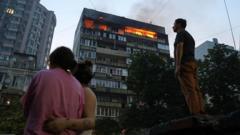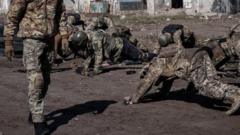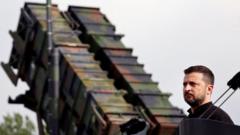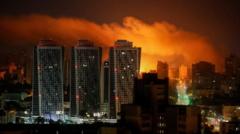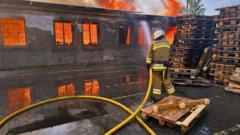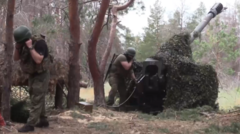As fighting escalates, Kursk Province bears the scars of war, with thousands displaced and a haunting landscape of death. Residents reflect on their shattered homes and lost lives amid the harsh realities of survival.
The Aftermath of War: Kursk Province in Ruins

The Aftermath of War: Kursk Province in Ruins
A bleak recount of the devastation in Kursk Province following Ukraine's military incursion.
In the wake of last year's military action, Kursk Province has transformed into a stark reminder of warfare's toll, with civilian lives deeply affected. Once a vibrant locality, it is now marked by destruction, where homes lay in ruins and haunting memories linger over the devastation that unfolded.
The conflict took a serious turn when Ukraine's forces advanced, capturing towns like Sudzha, known for its pivotal natural gas transit station. The fighting resulted in a dangerous stalemate, trapping civilians who had no option but to wait in dire conditions devoid of essential services. The brutal winter added to their suffering, as many fought to survive in the absence of heat and medical aid.
The regional governor reported grim statistics, with over 300 confirmed dead and nearly 600 individuals missing—figures that underscore the catastrophic impact of the war, though independent verification remains elusive. Interviews with survivors reveal the heart-wrenching reality of communal graves, with many having taken part in laying neighbors to rest, often in makeshift ceremonies amid ongoing chaos.
A walk through the ravaged landscape unearths a grim scene, where the corpses of both civilians and soldiers, alongside livestock, litter the fields, reflecting the sheer intensity of conflict. Visible military uniforms predominantly belong to Russian soldiers, adding a layer of complexity and tragedy to the narrative of loss.
As reports of bodies left unburied multiply, the depths of the humanitarian crisis become evident. The once-bustling communities now stand as somber reminders of lives interrupted and futures uncertain, as residents face an extended wait to see whether their homes can be rebuilt as the scars of war remain.
The conflict took a serious turn when Ukraine's forces advanced, capturing towns like Sudzha, known for its pivotal natural gas transit station. The fighting resulted in a dangerous stalemate, trapping civilians who had no option but to wait in dire conditions devoid of essential services. The brutal winter added to their suffering, as many fought to survive in the absence of heat and medical aid.
The regional governor reported grim statistics, with over 300 confirmed dead and nearly 600 individuals missing—figures that underscore the catastrophic impact of the war, though independent verification remains elusive. Interviews with survivors reveal the heart-wrenching reality of communal graves, with many having taken part in laying neighbors to rest, often in makeshift ceremonies amid ongoing chaos.
A walk through the ravaged landscape unearths a grim scene, where the corpses of both civilians and soldiers, alongside livestock, litter the fields, reflecting the sheer intensity of conflict. Visible military uniforms predominantly belong to Russian soldiers, adding a layer of complexity and tragedy to the narrative of loss.
As reports of bodies left unburied multiply, the depths of the humanitarian crisis become evident. The once-bustling communities now stand as somber reminders of lives interrupted and futures uncertain, as residents face an extended wait to see whether their homes can be rebuilt as the scars of war remain.

